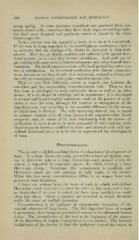Page 580 - My FlipBook
P. 580
590 DENTAL EMBRYOLOGY AND HISTOLOGY.
group .'spring. In some instances osteoblasts are produced from con-
net'tive-tissue cells; sometimes they have their origin in cartilage-cells;
but their most Irequent and persistent source is found in the white
blood-corpuscles.
Nature always uses the material at hand, in so far as it is available.
If the bone is being deposited by intercartilaginous ossification, there is
no necessity that the cartilage-cells should be destroyed or materially
altered. They are, no doubt, modified and endowed with special func-
tional powers ; in a word, they become osteoblasts. And such use of
pre-existing cells may occur in intramembranous and subperiosteal bone-
formation. The fixed connective-tissue cells in all probability act as cen-
tres of calcification. In interstitial ossification true fibrous connective
tissue has not as yet been found ; it is embryonic connective tissue, and
the cells are consequently embryonic connective-tissue cells.
There is very little difference, except as regards size, between the
osteoblast and the surrounding connective-tissue cells. Thus we find
that bone is developed in truly embryonic tissue as well as in older
tissues ; it is developed in cartilage and in membranes ; it is developed
in normal and in pathological conditions ; and yet the process of ossifi-
cation is ever the same, although the location or arrangement of the
deposition may vary according to the essential differences in the tissues
in which bone is formed. The only unvarying element that is found
in intimate relation with all these tissues is the migrated white blood-
corpuscle ; and, by reason of its close relationship with the process of
ossification, it seems to me to be more reasonable to infer that the white
blood-coi'puscle becomes modified in form and endowed with such spe-
cialized functional power as to be able to superintend the development
of bone.
Cementification.
This is only a slightly-modified form of Kubperiosteal development of
bone. In mature tissues the pulji, covered by a layer of dentine vary-
ing in thickness, acts as a large Haversian canal, around which the
cement is dejiosited in concentric layers, the whole forming a large
Haversian system. Sometimes this arrangement is modified, and
Haversian canals are seen running at right angles to the surface.
AMien this does occur, cementification differs in no respect from sub-
jx'riosteal b()ne-formati(jn.
I have cut sections from the roots of teeth in which well-defined
Haversian canals were seen to enter the sides of the roots, and I have
no doubt that if we were to search for them more carefully we could
often find them. Quite a number are recorded in dental literature
under the name of mu/fipfe foramina.
Cementification is the analogue of subperiosteal formation of the
cortical substance of long bones. The first deposited layer of cement
is permanent, there being no provisional cement to be afterward broken
down. The circumference of the root at the beginning of the process
of the de])ositi()n of cement is as great as it ever attains. The increase
in thickness of the dentine is from the periphery toward the centre, at


